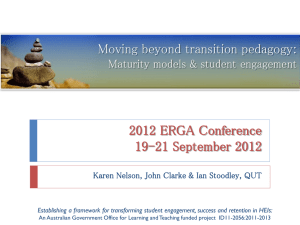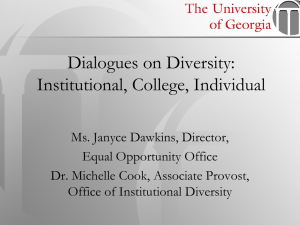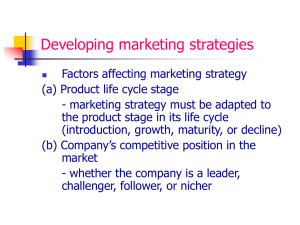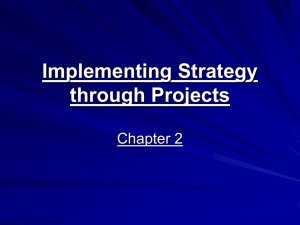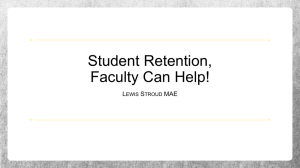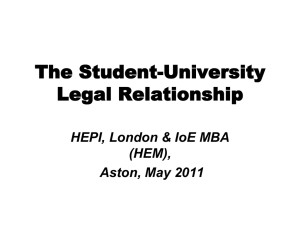SESR-MM - Student Engagement Maturity Model
advertisement
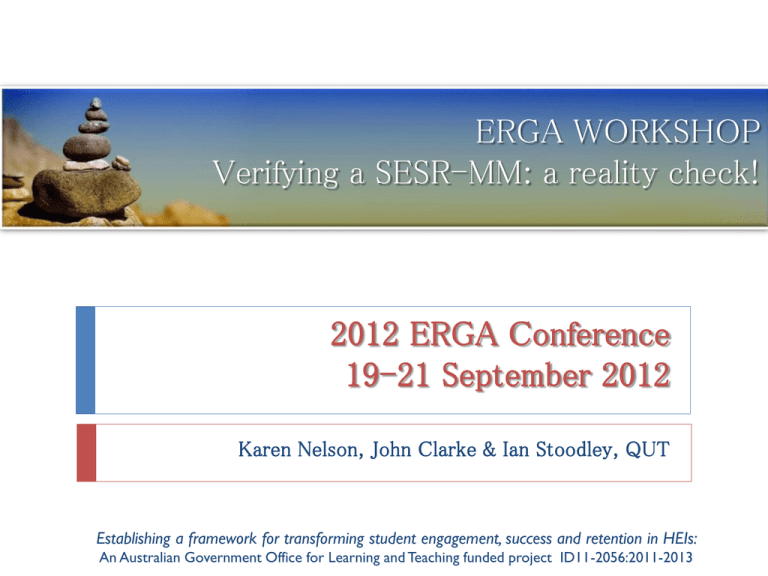
ERGA WORKSHOP Verifying a SESR-MM: a reality check! 2012 ERGA Conference 19-21 September 2012 Karen Nelson, John Clarke & Ian Stoodley, QUT Establishing a framework for transforming student engagement, success and retention in HEIs: An Australian Government Office for Learning and Teaching funded project ID11-2056:2011-2013 The need for an holistic view ... .... We have now reached the stage where universities must recognise the need for institution-wide approaches to enhancing the first year experience. Responsiveness to the needs of demographic and cultural subgroups demands that student support staff, academics and administrators work together to integrate their efforts and initiatives for the benefit of all students... Krause, Hartley, James & McInnis, 2005, ¶8.8.6 2 Establishing a framework for transforming student engagement, success and retention in HEIs: An Australian Government Office for Learning and Teaching funded project ID11-2056:2011-2013 Workshop Activities Part 1: Setting the scene Background to project: rationale, significance, & objectives Beyond the transition pedagogy Overview of maturity models Part 2: The SESR-MM Parts of the SESR Model A worked example Part 3: Verifying the model Developing a maturity assessment scale Assessing the maturity of one institutional practice Discussion 3 Establishing a framework for transforming student engagement, success and retention in HEIs: An Australian Government Office for Learning and Teaching funded project ID11-2056:2011-2013 Part 1: Setting the scene Focusing on the project .... 4 Establishing a framework for transforming student engagement, success and retention in HEIs: An Australian Government Office for Learning and Teaching funded project ID11-2056:2011-2013 Rationale Existing bodies of work report on students perceptions and their experiences in higher education (e.g. AUSSE, CEQ, FYEQ, UES, ISB...) No similar attention to sector-wide assessment of institutional activities designed to enhance students learning experiences Timing for the sector – WP, performance based funding, compacts, increased attention to HE reputation, quality ... Concept of a maturity model appealing: 5 Focus on sustainable processes Enable contextual interpretation of activities Assess other organisational imperatives (e.g. Quality, BPM) Establishing a framework for transforming student engagement, success and retention in HEIs: An Australian Government Office for Learning and Teaching funded project ID11-2056:2011-2013 Project Activities & Timeline Key Activities Timeframe Develop a SESR Maturity Model (SESR-MM) Oct 2011 - Sept 2012 • Conceptual model from literature analysis (top down) • Categories derived from practices and processes identified through workshops in team institutions (bottom up) Design a SESR Maturity Inventory Feb – Dec 2012 Conduct SESR Maturity Assessments in 3 institutions Develop a series of Case Studies to explain & describe SESR maturity in the context of each institution. Feb – April 2013 March - May 2013 Publish Institutional Maturity Reports (team institutions) June - July 2013 Develop & publish a Sector SESR Maturity Model Report (model, case studies & tools) August - Sept 2013 • 3 stage process: desk-top audit, workshops & interviews. 6 Establishing a framework for transforming student engagement, success and retention in HEIs: An Australian Government Office for Learning and Teaching funded project ID11-2056:2011-2013 Informing Literature Capability Maturity Models Transition Pedagogy Student Engagement (AUSSE) 7 SESR-MM FYEQ Data & Reports Model of student engagement Establishing a framework for transforming student engagement, success and retention in HEIs: An Australian Government Office for Learning and Teaching funded project ID11-2056:2011-2013 Maturity Models Precursors in Maslow’s (1954) Hierarchy of Needs and Nolan’ (1973, 1979) Stage Theory Influenced by TQM and the evolutionary stages of practice adoption (Crosby, 1979) Emergence of Capability Maturity Models Key concepts of org. Mgt derived from TQM Notions of sequential and progressive stages Ideas about capability of s/ware development orgs CMM frameworks map an improvement path from ad-hoc immature to a mature disciplined processes 8 Establishing a framework for transforming student engagement, success and retention in HEIs: An Australian Government Office for Learning and Teaching funded project ID11-2056:2011-2013 Features of Maturity Models Precursor Influences Theory, practice, background and history of maturity models Content: Discipline theory and practice Categories Processes Practices 9 Dimensions of maturity Maturity of key practices interpreted for each dimension Measures Adequacy (scale of 4 points) Establishing a framework for transforming student engagement, success and retention in HEIs: An Australian Government Office for Learning and Teaching funded project ID11-2056:2011-2013 Content of models Category (5) Process (n) Practices (Nn) 10 Establishing a framework for transforming student engagement, success and retention in HEIs: An Australian Government Office for Learning and Teaching funded project ID11-2056:2011-2013 Planned Defined Managed categories Fully adequate Ad hoc Delivery processes Largely adequate practices Adequacy Partially adequate Dimensions Not adequate Content Optimising 11 Establishing a framework for transforming student engagement, success and retention in HEIs: An Australian Government Office for Learning and Teaching funded project ID11-2056:2011-2013 What we have found so far ? SESR Category Curricula that engage students in learning Access to support A sense of belonging Example Processes -engaging pedagogies -authentic assessment -feedback processes -proactive monitoring -extended service ‘hours’ -inclusive language & practice -develop successful identity -flexible delivery Example Practices -role plays -collaborative learning -monitoring student learning engagement -academic advising -peer programs -cultural competence -communication strategies -orientation and transition as a process -technologies that support flexible learning -whole of course design -academic & professional -staff development Capacity, resources, -promotion policies infrastructure, policy Establishing a framework for transforming student engagement, success and retention in HEIs: 12 -physical & virtual An Australian Government Office for Learning and Teaching funded project ID11-2056:2011-2013 Transition pedagogy Part 2: The SESR Maturity Model Introducing the SESR Maturity Model .... 13 Establishing a framework for transforming student engagement, success and retention in HEIs: An Australian Government Office for Learning and Teaching funded project ID11-2056:2011-2013 A worked example ... 14 Category Ad hoc Delivery Transition Planned to Uni Defined The delivery / provision/visibility Managed of Orientation Optimising Programs Integrated suite of programs / a holistic approach Process Generic & discipline programs Orientation programs are available to students Maturity Assessment: Pervasiveness & Adequacy Limited discrete programs Practice Dimensions No programs are provided Content Access to Support Establishing a framework for transforming student engagement, success and retention in HEIs: An Australian Government Office for Learning and Teaching funded project ID11-2056:2011-2013 SESR Content ... an example Access to Support Extended service hours Orientation Program Transition to University Virtual learning advisers On-line resources Accessible information Oevaluation informs design AH – discipline programs P – Suite of ongoing activities D– policies: type and quality M– outcomes are monitored Not adequate: No discipline programs available Partially adequate: Some disciplines offer programs Largely adequate: Most disciplines offer programs Fully adequate: All faculties / disciplines have programs 15 Establishing a framework for transforming student engagement, success and retention in HEIs: An Australian Government Office for Learning and Teaching funded project ID11-2056:2011-2013 Indicators of Maturity Assessing Maturity Processes First year experience & transition Practices Orientation activities Pervasiveness: Indicator Faculty / discipline orientation and / or transition programs are available to support students. Reach Defined Policies define program quality & type Managed Outcomes are monitored Optimised Evaluation information informs design 16 Partially adequate Planned Part of suite of transition activities Not adequate Ad hoc delivery Faculty/discipline programs Fully adequate Categories Access to support Largely adequate Content: Establishing a framework for transforming student engagement, success and retention in HEIs: An Australian Government Office for Learning and Teaching funded project ID11-2056:2011-2013 Indicators of Maturity Practice Example: Reach Orientation programs are available for students N 17 Pervasiveness Ad Hoc Delivery (Dimensions) Planning Defining Managing Optimising (Adequacy) P L F Establishing a framework for transforming student engagement, success and retention in HEIs: An Australian Government Office for Learning and Teaching funded project ID11-2056:2011-2013 Part 3: Applying the model Assessing the maturity of SESR processes 18 Establishing a framework for transforming student engagement, success and retention in HEIs: An Australian Government Office for Learning and Teaching funded project ID11-2056:2011-2013 Your turn to map a practice Content: Assessing Maturity Categories Name a category Processes Name of one process in this category Name one dimension of one practice. Practices Name one practice Planned Defined Managed Optimised 19 Not adequate Ad hoc delivery Fully adequate Reach Largely adequate Indicator Partially adequate Pervasiveness: Establishing a framework for transforming student engagement, success and retention in HEIs: An Australian Government Office for Learning and Teaching funded project ID11-2056:2011-2013 ERGA WORKSHOP Verifying a SESR-MM: a reality check! http://studentengagementmaturitymodel.net/ Thank you for participating in this workshop Please contact the authors or refer to the project web site for further information about this project. Establishing a framework for transforming student engagement, success and retention in HEIs: An Australian Government Office for Learning and Teaching funded project ID11-2056:2011-2013
